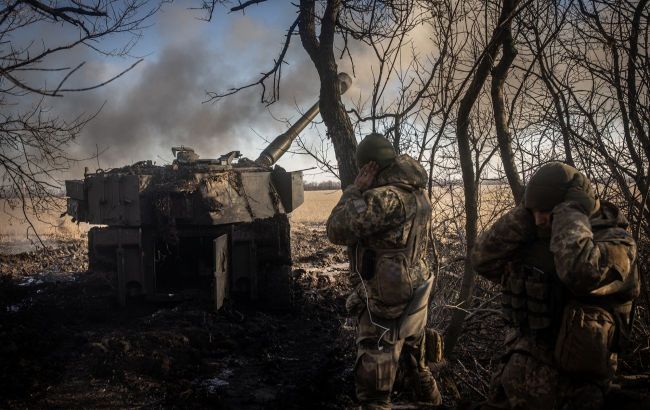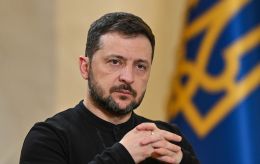Encirclement won't be allowed: Significance of Vuhledar and why Russia aims to capture city
 Photo: Russians are trying to encircle Vuhledar, Ukrainian Armed Forces are holding the line (Getty Images)
Photo: Russians are trying to encircle Vuhledar, Ukrainian Armed Forces are holding the line (Getty Images)
The situation around Vuhledar in the Donetsk region has become quite critical and continues to escalate. Russian troops are destroying the city with aerial bombs and artillery, attempting to maneuver around its flanks and encircle the settlement.
About the situation in Vuhledar, whether there is a threat of encirclement for the Ukrainian Armed Forces, and the plans of Russian troops, read in the RBC-Ukraine report below.
What is happening around Vuhledar, the threat of encirclement
Currently, the Russians have effectively managed to devastate the city. Andrii Kovalenko, the head of the Center for Countering Disinformation of the National Security and Defense Council of Ukraine, explained on his Telegram channel that Vuhledar was previously easy to defend due to its elevated position.
"However, with the active arrival of guided aerial bombs on the front line, the enemy has managed to destroy it and move to the flanks. Unfortunately, guided aerial bombs and aviation are the only factors allowing enemy infantry to advance," Kovalenko wrote.
According to the analytical project DeepState, the Russian army is trying to encircle the city while simultaneously leveling it to the ground. Forbes also cites this assessment.
The publication recalls that in January and February 2023, the Ukrainian 72nd Separate Mechanized Brigade named after the Black Zaporozhians defeated Russian troops, who outnumbered them, near Vuhledar. For two years, the brigade has defended this section of the front.
Oleksandr Musiienko, the head of the Сenter of Military Law Researches, commented to RBC-Ukraine that the enemy is currently advancing from three directions. He also emphasized that the Ukrainian command would not allow the encirclement of Ukrainian forces in Vuhledar.
"As soon as it becomes clear that due to the enemy's superior forces and the fact that they have deployed additional reserves, holding Vuhledar becomes more difficult, I believe Ukrainian troops will withdraw. The Ukrainian command will issue an appropriate order. Gradually, in combat, while preventing a breach in defensive lines, they will retreat. So, encirclement will not be allowed," Musiienko explained.
The expert emphasized that past experiences of the war show that when similar situations arose, Ukrainian troops held their positions as long as possible before executing a withdrawal.
The fighters of the 72nd Brigade themselves post videos online showing the destruction of Vuhledar. "Despite everything, we know our job and do it," the Ukrainian defenders briefly captioned the video.
Based on DeepState maps, the enemy is currently trying to bypass Vuhledar from the flanks. The monitoring project previously reported that Russian troops managed to occupy the villages of Prechystivka and Vodiane, located near Vuhledar on the western and eastern flanks, respectively.

Frontline situation as of September 25 (photo: DeepState maps)
According to Musiienko, Vuhledar plays a colossal role in the defensive operation in the east. Ukrainian units in the area are currently tying down a large grouping of enemy forces, inflicting maximum casualties on them.
Furthermore, the Armed Forces of Ukraine are effectively utilizing the landscape features — mines and rivers — to defend against and prevent the movement of Russian units toward Kurakhove and Pokrovsk.
"Thanks to this, Ukrainian forces managed to regroup and somewhat strengthen the defense in the Pokrovsk direction, stopping the enemy directly under Novhorodivka during frontal assaults. Thus, the grouping is carrying out a significant mission for the defense of the entire Kurakhove and Pokrovsk directions," Musiienko stated.
Why Russia wants to occupy the city
Meanwhile, analysts from the Institute for the Study of War and British intelligence also noted that Russian troops have significantly intensified their offensives in the Vuhledar area.
They claim that the Russians have allegedly achieved tactical successes in this area. According to ISW, Russia plans to capture the city to stretch the Armed Forces of Ukraine and prevent the redeployment of Ukrainian troops to strengthen the defense of Pokrovsk.
On the other hand, Musiienko explained that strategically, it is clear that for Russia, achieving the goal of seizing the Donetsk region is impossible without capturing Vuhledar.
"Secondly, it should be noted that they (Russian troops -ed.) want to use these heights for further advancement and offensive actions. Thirdly, they seek revenge against Ukrainian defenders, as they have suffered colossal losses during our forces' presence in Vuhledar. This concerns substantial losses in personnel and equipment," Musiienko noted.
He added that another goal of the Russians in continuing their offensive campaign is to level the front line.
"Another aspect is that the enemy fears that Ukraine might relocate long-range artillery to the heights in the Vuhledar area and reach Volnovakha from there, where there is an important railway line and hub for the enemy. These are the reasons why they have fought so hard," Musiienko added.
He emphasized that the fact that Vuhledar has held out for a long time has disrupted the enemy's plans significantly. When Russians began offensive actions in May in the Kharkiv region (a northern flanking point in the east), their plans may have included an offensive in the south.
"They viewed Vuhledar as a starting point to tighten the noose with these flanking attacks. The fact that Ukrainian troops did not allow this has significantly thwarted such enemy plans," Musiienko concluded.
It is worth noting that Vuhledar is a city in the Volnovakha district of the Donetsk region. Before the full-scale invasion by Russia, the city's population numbered around 15,000. According to Serhii Novikov, the head of the Vuhledar City Military Administration, only 107 people remain in the settlement who categorically refuse to evacuate.
Sources: the Telegram channel of Andrii Kovalenko, reports from ISW and British intelligence, DeepState, Forbes, and exclusive commentary from Oleksandr Musiienko.

